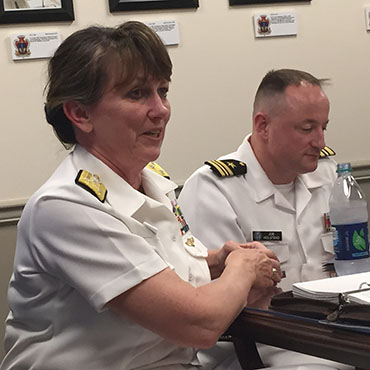Navy's new cyber strategy prioritizes threats

U.S. Fleet Cyber Command's five-year plan aims to avoid a repeat of the 2013 Iranian hack of the Navy Marine Corps Intranet.

Vice Adm. Jan Tighe (left), commander of the Navy's U.S. Fleet Cyber Command, briefs reporters at the Pentagon on May 6 with Lt. Comm. Joe Holstead.
Nearly two years after Iranian hackers poked holes in the Navy’s cyber defense, the service’s cyber command has released a strategy that tries to ensure that never happens again -- or at least minimizes the damage when it does.
One of the goals driving the new five-year strategy from U.S. Fleet Cyber Command is to “understand how successful we are being in prioritizing the most important threats that are coming at us and being able to respond with a sense of urgency,” Vice Adm. Jan Tighe, the head of the command and architect of the strategy, told reporters May 6 at the Pentagon.
Tighe wants what any head of a large enterprise would: awareness of network vulnerabilities. But the unique vastness of the networks she is charged with defending -- the Navy Marine Corps Intranet is one of the largest in the world -- has made that situational awareness elusive. So the new strategy sets out to give the Navy a common operating picture in cyberspace by deploying more sensors and other network tools.
“There are a lot of tools and technologies that are available today that are being piloted, tested and/or deployed in our system that will begin to improve my ability to see” threats, Tighe said. She declined to say what those technologies are, only that “most of them are commercial.”
The 2013 hack of the NMCI left a lasting impression on Tighe and other current and former Navy officials. The Iranian hackers took network diagrams of the Web portals bordering the unclassified and classified sections of the intranet, Brian Wallace, a researcher at cybersecurity firm Cylance, has told FCW. Although it was a reconnaissance mission rather than a destructive one, Wallace said much of the information taken by the hackers would be “useful in some form of attack.”
It would be months before the U.S. Fleet Cyber Command, with the help of other military service commands, the National Security Agency, and other agencies, were able to drive the hackers from the NMCI. The lessons of “Operation Rolling Tide,” as the maneuver was called, inform the new five-year strategy.
For example, Tighe wants her networks to better detect and thwart intrusions before they develop into more serious threats. “I’ve got to have a diversity of different kinds of sensors and blocking capabilities and the analytic horsepower to be able to respond to that,” she said.
This means being able to differentiate between run-of-the-mill botnets probing Navy networks and the “advanced persistent threats” of nation-states.
Situational awareness is one of the strategy’s five goals. Two of the other goals emphasize cyberspace as a war-fighting domain, another calls for expanding the service’s signal intelligence capabilities, while the last goal focuses on building out the Navy’s cyber mission force. The service has stood up about half of its 40 cyber protection teams, Tighe said, adding that feeding these teams improved analytics will help them better defend Navy networks.
Each of the five-year goals comes with a benchmark to measure progress after 18 months. That benchmark is a recognition that the strategy will need to adapt to a quickly changing cyber-threat landscape, Tighe said. “I don’t think the large, overarching goals would change, but I think the strategies by which we pursue them potentially could.”
NEXT STORY: DHS/NASA device helps rescue four in Nepal





